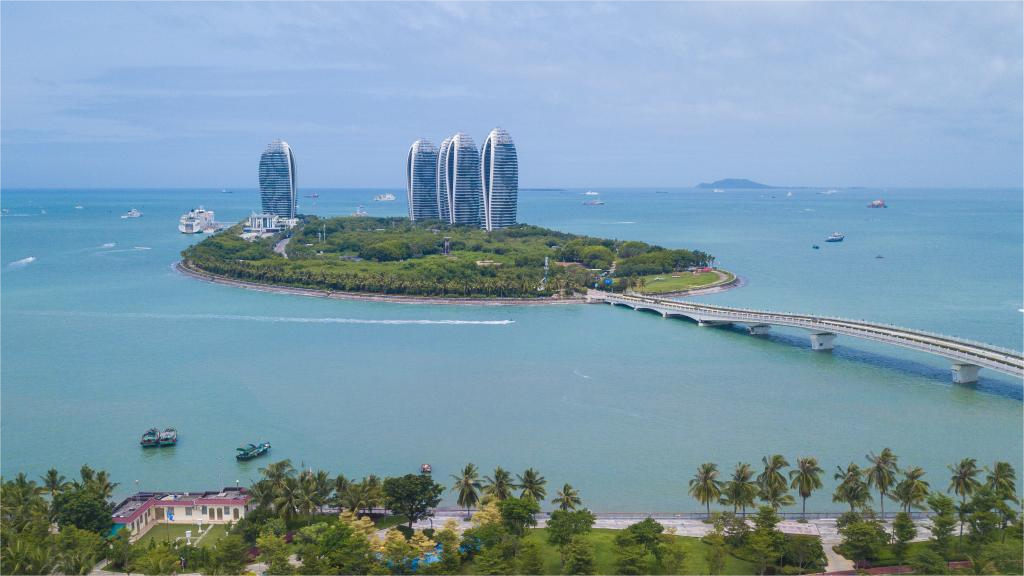Feature: Chinese-Built bridge spurs local business growth in Croatia

A car is seen on the Peljesac Bridge in Komarna, Croatia, on July 26, 2024. Since its inauguration in July 2022, the Chinese-built Peljesac Bridge in Croatia has significantly boosted local businesses, creating new economic opportunities and facilitating smoother transportation on the Adriatic coast. The 2.4-kilometer-long bridge connects Croatia's mainland with the Peljesac Peninsula on the country's southern Adriatic coast and was built by a consortium of Chinese enterprises led by the China Road and Bridge Corporation (CRBC). (Xinhua/Li Xuejun)
KOMARNA, Croatia, July 26 (Xinhua) -- Since its inauguration in July 2022, the Chinese-built Peljesac Bridge in Croatia has significantly boosted local businesses, creating new economic opportunities and facilitating smoother transportation on the Adriatic coast.
The 2.4-kilometer-long bridge connects Croatia's mainland with the Peljesac Peninsula on the country's southern Adriatic coast and was built by a consortium of Chinese enterprises led by the China Road and Bridge Corporation (CRBC).
It has brought opportunities to local businesses such as the Dingac-Skaramuca Winery, located 20 minutes drive from the bridge. The winery's sales director Branimir Andjelic told Xinhua: "We have seen lots of Chinese people visiting us in the winery and wine shops."
He added that the winery's featured product, Dingac, has seen a sharp increase in sales on the Chinese market since the bridge was built. Last year, a total of 1,000 bottles were sold in China, and in 2024 the figure could reach 3,000. The winery has a long-term goal of selling 20,000 bottles in China.
"I see great potential in China because lots of Chinese guests and partners have visited our vineyards and our cellar," Andjelic said.
Local resident Josipa Borovic worked for four years on the Peljesac Bridge project. She said: "It was an honor and a pleasure for me to work at the Peljesac Bridge project," adding that it had left her with "unforgettable memories." Borovic was unemployed when she applied to work in the human resources department of the Peljesac Bridge project in 2018.
"From the very beginning, it was a (...) wonderful environment, and it was actually easy to work with them. We clicked very quickly, and regardless of the language and cultural barrier, we cooperated perfectly," said Borovic, who later transferred to the administrative department until the end of the project in July 2022.
The Chinese team was hard-working and efficient, she said, allowing the project to be completed on schedule despite the COVID-19 pandemic. Previously, even without the pandemic, there had been several unsuccessful attempts to build the bridge.
"I feel proud and grateful to have had the opportunity to work with the Chinese team, and make a small contribution to the project," said Borovic, emphasizing the "significant role" played by the bridge in boosting tourism, transport, logistics, and other economic activities in southern Croatia.
According to CRBC Manager Lu Shengwei, more than 250 local people were employed by the Peljesac Bridge project, along with 18 design consulting companies, 45 construction companies from the European Union (EU), and 112 equipment and material suppliers from Croatia, Germany, Poland, and other countries.
In the two years since its inauguration, nearly 5 million vehicles have already crossed the bridge.
The bridge also means that tourists and logistics drivers no longer have to detour through the Neum Corridor in Bosnia and Herzegovina to go to Dubrovnik, Korcula, and other cities in southern Croatia, or deal with cumbersome entry and exit procedures and long queues.
The Peljesac Bridge, a major infrastructure project under the China-proposed Belt and Road Initiative (BRI), has been an example of mutually beneficial cooperation between China, Croatia, and the EU, according to Qi Qianjin, Chinese ambassador to Croatia.

People take souvenir photos in front of the Peljesac Bridge in Komarna, Croatia, on July 26, 2024. Since its inauguration in July 2022, the Chinese-built Peljesac Bridge in Croatia has significantly boosted local businesses, creating new economic opportunities and facilitating smoother transportation on the Adriatic coast.
The 2.4-kilometer-long bridge connects Croatia's mainland with the Peljesac Peninsula on the country's southern Adriatic coast and was built by a consortium of Chinese enterprises led by the China Road and Bridge Corporation (CRBC). (Xinhua/Li Xuejun)

People take souvenir photos in front of the Peljesac Bridge in Komarna, Croatia, on July 26, 2024. Since its inauguration in July 2022, the Chinese-built Peljesac Bridge in Croatia has significantly boosted local businesses, creating new economic opportunities and facilitating smoother transportation on the Adriatic coast.
The 2.4-kilometer-long bridge connects Croatia's mainland with the Peljesac Peninsula on the country's southern Adriatic coast and was built by a consortium of Chinese enterprises led by the China Road and Bridge Corporation (CRBC). (Xinhua/Li Xuejun)
Photos
Related Stories
- Interview: 8th China-South Asia Expo boosts regional trade, investment cooperation: Cambodian official
- BRI brings opportunities for cultural and tourism exchanges
- Brazil’s interest in joining BRI shows that win-win cooperation prevails
- China aims to elevate BRI cooperation toward higher quality for modernization of all countries
- Feature: Lao entrepreneur seeks business opportunities at China-South Asia Expo
- China welcomes Brazil to join Belt and Road family as soon as possible: spokesperson
Copyright © 2024 People's Daily Online. All Rights Reserved.









